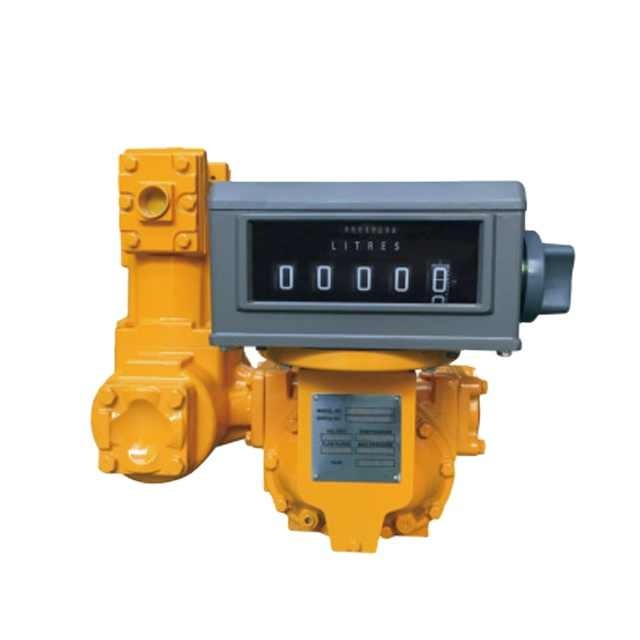
Positive Displacement Flow Meter
Rp123000.00
A Positive Displacement (PD) Flow Meter is a highly accurate and reliable flow measurement device used to measure the volume of liquids or gases in a wide range of industrial applications. The working principle of a PD flow meter is based on the displacement of a known volume of fluid with each cycle of the meter. As fluid enters the flow meter, it displaces a measuring chamber or mechanism that moves a set of components (such as gears, pistons, or diaphragms). The movement of these components is directly proportional to the volume of fluid passing through the meter, making PD flow meters extremely precise.
Positive displacement meters are ideal for applications requiring high accuracy over a wide flow range, especially where the flow rate is low or highly variable. These flow meters are widely used in industries like oil and gas, food and beverage, chemicals, and pharmaceuticals, where precise volume measurement is critical.
Key Features:
High Accuracy: Positive displacement flow meters are known for their high accuracy, often providing accuracy within ±0.1% of reading or better, making them ideal for custody transfer and precision applications.
Wide Flow Range: PD meters are effective across a broad range of flow rates, from very low flow rates to high volumes, ensuring flexibility in different applications.
No Need for Calibration: Due to their mechanical operation, PD flow meters generally require minimal calibration and offer reliable performance over time.
Low Pressure Drop: These meters typically have low pressure drops compared to other flow meters, which helps maintain system efficiency.
Bidirectional Measurement: Some PD flow meters can measure flow in both directions, making them ideal for systems where the flow direction might change.
Simplicity of Design: The simple, mechanical operation of a PD meter ensures reliability and ease of maintenance.
Mechanical or Digital Readout: PD flow meters can be equipped with mechanical or electronic registers for easy reading of flow measurements.
Types of Positive Displacement Flow Meters:
Gear Meters: Gear flow meters use two or more meshing gears to displace fluid. As the fluid passes through the meter, the gears rotate, and the volume of fluid is calculated based on the number of gear rotations.
Applications: Oil, fuel, chemicals, and food products.
Piston Meters: These meters use a piston that moves back and forth within a cylinder. As fluid enters, it pushes the piston, and the movement is used to measure flow.
Applications: Custody transfer, high-precision fluid metering.
Diaphragm Meters: In these meters, a diaphragm flexes with the pressure of the fluid, and this movement displaces a known volume of fluid, allowing for accurate measurement.
Applications: Water, chemicals, and pharmaceuticals.
Rotary Vane Meters: These meters have a rotating vane that is driven by the flow of liquid, with the volume measured based on the rotation of the vane.
Applications: Fuel oil, lubricants, and other petroleum products.
Specifications:
Flow Range: Typically from 0.1 GPM (gallons per minute) to over 1000 GPM, depending on the model and application.
Accuracy: ±0.1% to ±1% of reading.
Operating Pressure: Can handle pressures up to several thousand psi, depending on the meter design and materials.
Temperature Range: Generally -40°C to 150°C (-40°F to 302°F), but can vary depending on material and application.
Material of Construction: Stainless steel, carbon steel, aluminum, or other corrosion-resistant materials, depending on the fluid type and environmental conditions.
Output: Mechanical registers, electronic displays, or pulse output for data collection and integration with control systems.
Viscosity Range: PD meters can handle a wide range of fluid viscosities, making them suitable for both low-viscosity liquids (like water) and high-viscosity liquids (like oils).
Applications:
Oil and Gas: For accurate custody transfer measurements of crude oil, natural gas, and refined petroleum products.
Chemical and Pharmaceutical: For precise measurement of chemicals and pharmaceutical fluids, ensuring accurate dosing and regulatory compliance.
Food and Beverage: Used to measure ingredients or finished products like milk, juices, syrups, and oils with high accuracy.
Water and Wastewater: For metering water consumption, managing system flow, and measuring wastewater in treatment facilities.
HVAC: For measuring the flow of heating and cooling fluids in heating, ventilation, and air conditioning systems.
Benefits:
High Accuracy: PD flow meters provide exceptional accuracy and are particularly useful for applications requiring precise volumetric measurements.
Simple Operation: The mechanical operation of the meter is easy to understand and maintain, which reduces the likelihood of measurement errors or system failure.
Versatile: Suitable for a wide range of fluid types and flow conditions, from low to high flow rates and varying viscosities.
Reliability: Proven to provide reliable and consistent measurements over extended periods with minimal wear and tear.




